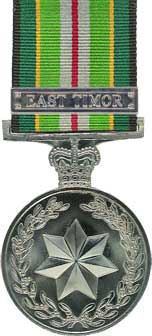Established 13 September 1988 | Status Currently issued | |
 | ||
Awarded for Service in prescribed warlike operations Total awarded 62,210 as at 30 June 2010 Next (higher) Australian Active Service Medal 1945–1975 | ||
The Australian Active Service Medal is an Australian military decoration. It was authorised 13 September 1988 to recognise prescribed service in warlike operations. It is awarded with a clasp to denote the prescribed operation and subsequent awards of the medal are made in the form of additional clasps.
Contents
Description
The AASM is a circular nickel-silver medal ensigned with the Crown of St Edward. The obverse has a Federation Star within a wreath of mimosa and bears a laurel wreath surrounding the inscription 'FOR ACTIVE SERVICE'.
The medal ribbon is 32 millimetres wide and has a central red stripe to symbolise the danger of warlike operations. It is flanked by stripes of silver-green which in turn are flanked by stripes of light green, gold, dark green and brown.
The ribbon bar consists of a strip of full-sized ribbon with no emblem.
Balkans
1 day of service (or 1 sortie) with the United Nations Peacekeeping activities in the former Yugoslavia (UNPROFOR, UNMIBH, UNCRO, UNPREDEP, UNTAES) from 12 January 1992 to 24 January 1997.Cambodia
1 day of service (or 1 sortie) with the United Nations Transitional Authority in Cambodia (UNTAC) from 20 October 1991 to 7 October 1993.East Timor
1 day of service (or 1 sortie) with the:ICAT
1 day of service (or 1 sortie) as part of the International Coalition Against Terror:Iraq
1 day of service (or 1 sortie) in the area comprising Iraq for service as a member of the ADF assigned for service to:Iraq 2003
1 day of service (or 1 sortie) in the Middle East Area as part of the:Kuwait
Service with the multinational deployment in the Persian Gulf from 17 January 1991 to 28 February 1991.Service on HMAS Canberra during Operation Damask VI from 13–19 January 1993.Middle East
Service of 1 or more days with the United Nations Truce Supervisory Organisation (UNSTO) in southern Lebanon from 12 July 2006 to 14 August 2006.Namibia
30 days of service with the United Nations Transitional Assistance Group (UNTAG) from 18 February 1989 to 10 April 1990.Rwanda
1 day of service with the United Nations Assistance Mission for Rwanda, Operation Tamar, from 25 July 1994 to 8 March 1996.Sierra Leone
Service of 1 or more days with the International Military Advisory and Training Team or attached to British forces involved in Operation Husky from 15 January 2001 to 28 February 2003.Somalia
1 day of service (or 1 sortie) with the:Vietnam 1975
1 day of service associated with RAAF activities with Transport Support Flight Butterworth or HQ Richmond Detachment 'S' to UNICEF, from 29 March 1975 to 28 April 1975.Returned from Active Service Badge
Recipients of the Australian Active Service Medal are also entitled to the issue of the Returned from Active Service Badge (RASB).
The RASB is the only Campaign Service badge awarded post-World War II. It is worn on the left lapel and only in civilian attire, to reflect that the recipient has been involved in warlike service. The brass badge has a serial number with a prefix denoting the member's service, and has been awarded since 1945 where the only change to its appearance has been the replacement of the King George VI's crown with that of the Queen Elizabeth's.
Unlike most awards, the RASB is not issued to deceased members or the next-of-kin, as the badge represents a return from the member's warlike service. The replacing of the AASM with the Operational Service Medal was announced in May 2012; the RASB has been retired with the AASM, with the Operational Service Badge filling the role of being a badge indicative of a members' warlike service.
Related medals
A separate campaign medal in the Australian system is awarded for major operations and wars, and is issued concurrently with the AASM. These are referenced under their respective clasps.
Personnel who receive this medal may also be entitled to receive a service or campaign medal from an international organisation or the host country, if they meet the eligibility criteria for those medals. These are treated as foreign medals in the Australian system, and if approved for wear on service uniforms, are worn after Australian medals in the order they are received. Recipients of the ASM may be authorised to wear two or three further medals for the same period of service; an Australian campaign medal, a medal from an international organisation and a medal from a host nation.
Some of the international and host nation medals have been granted a blanket authority for all recipients to wear. Others are approved on an individual basis.
